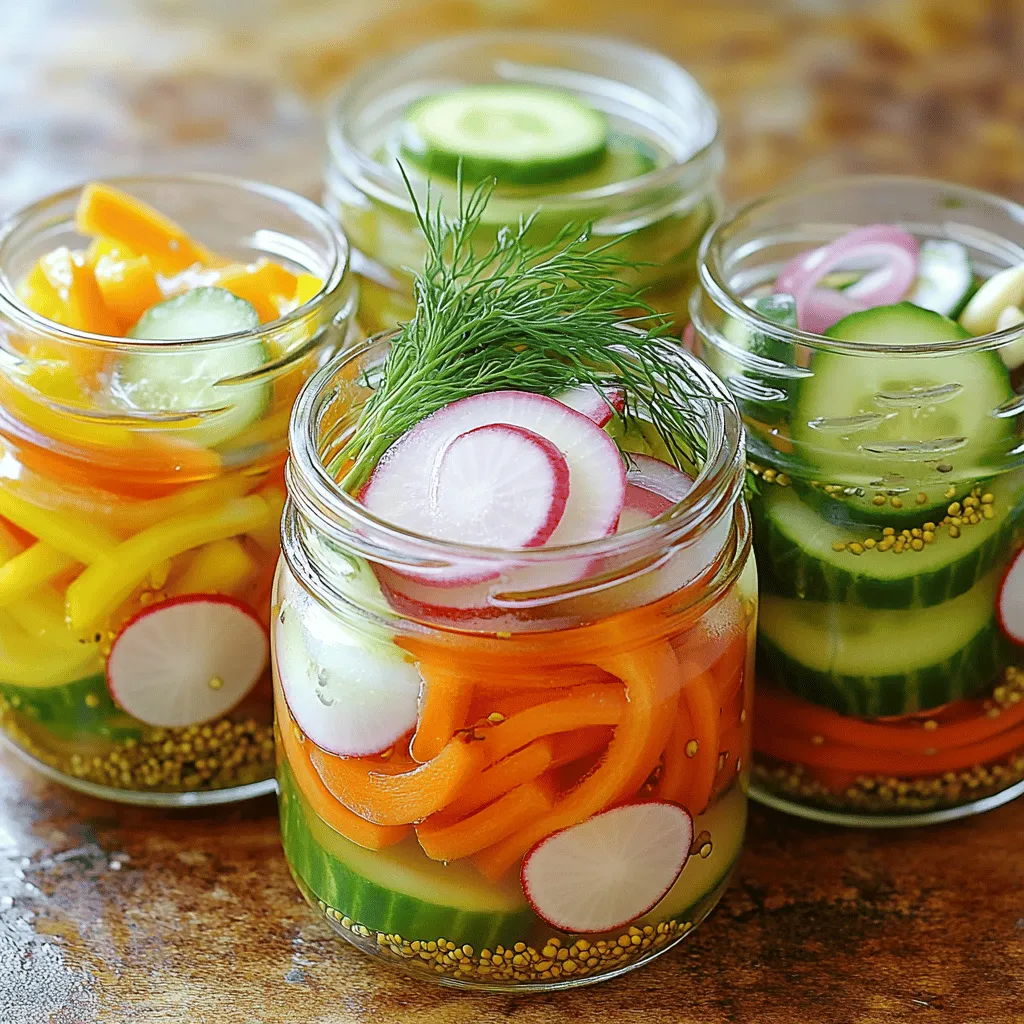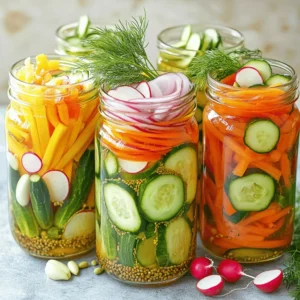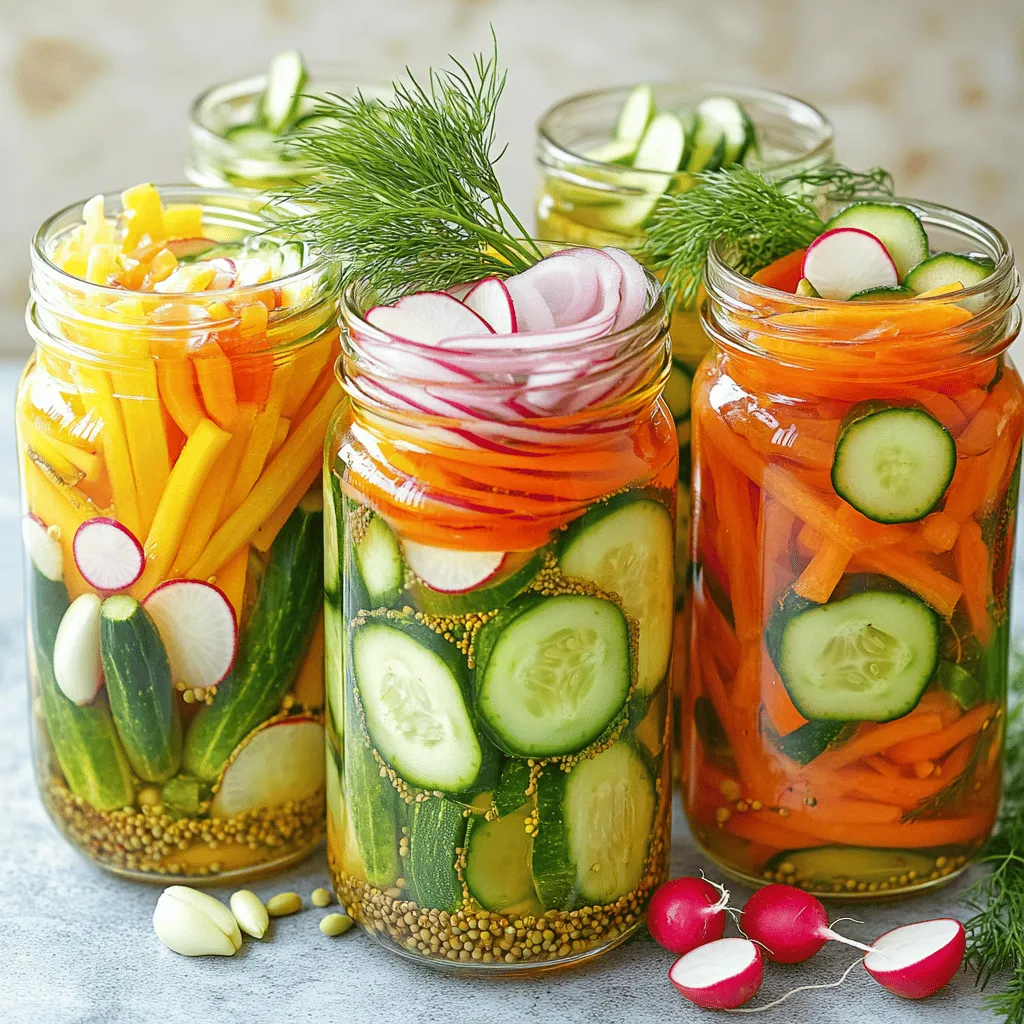Are you looking for a tasty and healthy snack? Pickled vegetables offer a crunchy bite and bold flavors that pack a nutritious punch. In this guide, I’ll show you how to make your own vibrant pickled veggie medley using fresh ingredients. You’ll learn easy steps, helpful tips, and the health benefits of pickled snacks. Let’s dive into the world of pickling and transform your snacking experience!
Ingredients
List of Ingredients for Vibrant Pickled Veggie Medley
To create a tasty pickled veggie medley, gather these fresh ingredients:
– 1 cup carrots, julienned
– 1 cup cucumbers, sliced
– 1 cup radishes, sliced
– 1 cup bell peppers (any color), sliced
– 1 cup red onions, thinly sliced
– 2 cups water
– 1 cup apple cider vinegar
– 2 tablespoons sugar
– 1 tablespoon salt
– 1 teaspoon mustard seeds
– 1 teaspoon coriander seeds
– 1 teaspoon black peppercorns
– 2 garlic cloves, smashed
– Fresh dill sprigs (optional for extra flavor)
Measurement Tips for Accurate Results
When measuring ingredients, use dry measuring cups for solids. For liquids, use a liquid measuring cup. This helps ensure your pickled veggies turn out great. Make sure to level off dry ingredients with a knife. This way, you avoid using too much or too little. Remember, accurate measures lead to perfect flavors!
Importance of Freshness in Ingredients
Fresh ingredients are key for great pickles. They add crunch and vibrant taste. Old or wilted veggies can lead to mushy pickles. Always choose firm, colorful veggies. This guarantees that your pickled medley will have a bright look and a delightful crunch. Freshness also enhances the overall flavor, making your healthy snack even more enjoyable.
Step-by-Step Instructions
How to Prepare the Pickling Brine
To make a great pickling brine, start with a saucepan. Add 2 cups of water and 1 cup of apple cider vinegar. Then, add 2 tablespoons of sugar and 1 tablespoon of salt. Stir in 1 teaspoon of mustard seeds, 1 teaspoon of coriander seeds, and 1 teaspoon of black peppercorns. Finally, add 2 smashed garlic cloves. Heat this mixture over medium heat and stir until the sugar and salt dissolve. Once boiling, remove the saucepan from heat and let it cool for 10-15 minutes.
Tips for Preparing Vegetables Properly
Properly preparing your vegetables is key to great pickles. First, wash all your veggies thoroughly. For the carrots, julienne them into thin strips. Slice cucumbers, radishes, and bell peppers into bite-sized pieces. Thinly slice the red onion. This helps all the veggies soak in the brine well. If you want extra flavor, add fresh dill sprigs to your jar. This step adds a nice herbal touch.
Storage and Cooling Techniques
Once your brine is cool, place your prepared veggies into a large glass jar or an airtight container. Pour the brine over the veggies, making sure they stay submerged. You might need to press them down with a spoon. Seal the jar tightly and place it in the fridge. Let the vegetables pickle for at least 24 hours. For the best taste, let them sit for 3-5 days. Enjoy your pickled veggies as a healthy snack or topping for meals.
Tips & Tricks
Best Practices for Pickling Vegetables
Pickling vegetables is fun and simple. Choose fresh, crisp veggies for the best taste. Wash them well and cut them into even pieces. This helps them pickle evenly. Always use clean jars to avoid contamination. I like to sterilize my jars in boiling water before use.
How to Enhance Flavor with Herbs and Spices
To add more flavor, use herbs and spices in the brine. Garlic and dill work great. You can also add red pepper flakes for heat. Experiment with flavors! Mustard seeds and coriander seeds give a nice crunch and extra taste. Just remember to keep it balanced. Too many spices can overpower the veggies.
Common Mistakes to Avoid When Pickling
One common mistake is not letting the brine cool enough before pouring it over veggies. Hot brine can cook the vegetables and change their texture. Another mistake is not using enough salt. Salt helps preserve the veggies and adds flavor. Don’t skip the sugar, either! It balances the acidity of vinegar. Lastly, remember to seal the jars tightly to keep the flavors in.
For a vibrant pickled snack, check out the Full Recipe for my Vibrant Pickled Veggie Medley.

Health Benefits of Pickled Vegetables
Nutritional Advantages of Eating Pickled Vegetables
Pickled vegetables are tasty and healthy. They are low in calories and high in nutrients. For example, cucumbers are rich in vitamins K and C. Carrots provide beta-carotene, good for your eyes. Radishes add fiber, which helps you feel full. These veggies also keep your meals colorful and fun.
How Pickled Vegetables Contribute to Digestive Health
Eating pickled vegetables can help your tummy. They often contain probiotics. Probiotics are good bacteria that aid digestion. These bacteria can improve gut health. They help break down food, making it easier to digest. This can reduce bloating and discomfort. Plus, the vinegar in pickles may help your body absorb nutrients better.
Incorporating Pickled Vegetables into a Healthy Diet
You can add pickled veggies to many meals. They make a great snack on their own. Try them in salads or on sandwiches for extra crunch. You can also mix them into grain bowls or tacos. Their tangy taste adds flavor without extra calories. For a fun treat, follow the full recipe to make your own vibrant pickled veggie medley.
Variations & Serving Suggestions
Creative Variations of Pickled Vegetables
You can play with pickled vegetables in many fun ways. Try using different veggies to make your own mix. Instead of cucumbers, you can use zucchini or green beans. For a spicy kick, add sliced jalapeños or radishes. You can even mix in fruits like mango or peach for a sweet touch. Each veggie or fruit adds its own flavor, making your pickles unique.
Pairing Pickled Vegetables with Other Foods
Pickled vegetables shine when paired with other foods. They make a great side dish for grilled meats or fish. Serve them on a cheese platter for a crunchy bite. You can also add them to sandwiches or wraps for extra flavor. Their tangy taste compliments rich dishes well. For a simple snack, enjoy them with hummus or dip.
Ideas for Using Pickled Vegetables in Meals
You can use pickled vegetables in many meals. Top your salads with them for a crunchy twist. Add them to tacos for a zesty layer. They also work great in grain bowls, adding texture and taste. You might want to mix them into pasta salads or rice dishes. They can even spice up a simple omelet. Be sure to try my Full Recipe for a vibrant pickled veggie medley!
FAQs
How long do pickled vegetables last?
Pickled vegetables can last up to two months in the fridge. The brine helps preserve them. After that time, the taste may change. Always check for off smells or mold before eating.
Can I use different types of vegetables for pickling?
Yes, you can use many types of vegetables! Carrots, cucumbers, radishes, and bell peppers work well. You can also try green beans, cauliflower, and even asparagus. The key is to cut them into similar sizes for even pickling.
Are pickled vegetables a healthy snack option?
Absolutely! Pickled vegetables are low in calories and high in fiber. They pack vitamins and minerals, too. They can aid digestion and add crunch to your meals. Just watch the sodium if you’re keeping track of salt intake.
What is the best way to store homemade pickled vegetables?
Store your pickled vegetables in a glass jar with a tight lid. Keep them in the fridge. This keeps them fresh and crisp. Make sure they are fully submerged in brine to prevent spoilage.
How do I know when pickled vegetables are ready to eat?
Pickled vegetables are usually ready after 24 hours in the fridge. For the best flavor, wait 3 to 5 days. Taste them to see if the flavors have melded well. They should have a tangy, crisp texture.
For a tasty recipe, try the Vibrant Pickled Veggie Medley!
In this article, we covered the essentials for making a vibrant pickled veggie medley. We explored ingredient choices, preparation steps, and tips for best results. I shared the health benefits of pickled vegetables and creative serving ideas. Remember, using fresh ingredients is key. By practicing the tips provided, you can avoid common mistakes. Enjoy your journey into pickling veggies. It’s a fun way to add flavor and nutrition to your meals.

